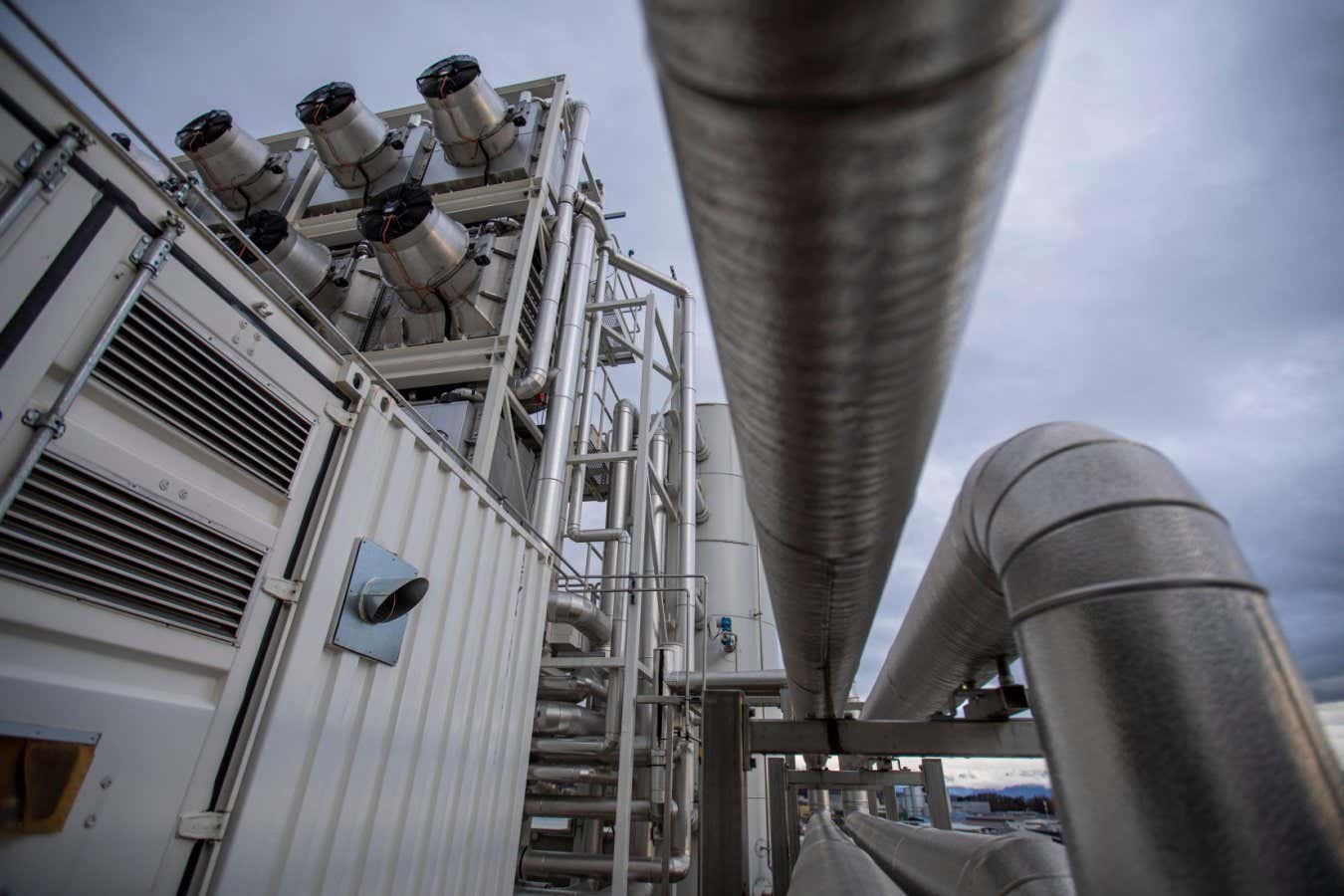
This direct air capture system can pull carbon dioxide from the air for later reuse – but it requires a lot of energy
Orjan Ellingvag / Alamy
Light-sensitive molecules called photoacids could make the process of removing carbon dioxide from the atmosphere more energy efficient. Researchers are now devising ways to make photoacids more practical to use.
This could be especially valuable for direct air capture (DAC) systems, which blow air over carbon-capturing materials called sorbents. Existing systems require a large amount of energy to separate pure CO2 from sorbents in order to store or use it elsewhere. This poses a major barrier to using DAC to remove billions of tonnes of CO2 from the atmosphere each year. “That step is hitting a wall,” says Anna de Vries at ETH Zurich in Switzerland. “Every single direct air capture company is struggling and trying to make the most efficient process.”
Adding photoacids to the sorbents could help. When illuminated, each photoacid molecule changes shape and releases a proton, making the solution more acidic. This “pH swing” frees CO2 from the sorbent-photoacid mixture. When the lights go out again, the photoacids – and the solution’s pH – revert, allowing the sorbent to absorb CO2 once more. Then the cycle can be repeated.
Usually heat or pressure is used to release the CO2, but using sunlight or lamps could slash the energy needed for this step, says de Vries, who aims to halve DAC’s energy requirements. However, photoacids tend to be unstable and not very soluble in water, which limits the efficiency with which they can release CO2.
De Vries and her colleagues added various solvents to a photoacid solution and found a mix that makes photoacids more soluble and extends their lifespan from just a few hours to nearly a month.
In another approach, Uvinduni Premadasa at Oak Ridge National Laboratory in Tennessee and her colleagues found a different photoacid that can maintain its response to light longer and produce more acid, enabling it to release CO2 from a solution more efficiently.
Greg Mutch at Newcastle University in the UK says these are “elegant and innovative” solutions. However, he says a scaled-up system could face challenges – for example, losing solvent to evaporation in the air.
While these researchers focused on capturing CO2 from the atmosphere, the first larger-scale test for photoacids may happen in water. A start-up called Banyu Carbon in Washington state is using photoacids to separate CO2 from seawater, with plans to install a system that can remove one tonne of CO2 per year in 2024.
In this system, photoacids are exposed to light and the resulting acidity is temporarily transferred to seawater, causing the water to release CO2 absorbed from the atmosphere. Alex Gagnon, the company’s co-founder, says this cuts the energy needed to separate out CO2 and eliminates the need to power fans.
Topics:

Felecia Phillips Ollie DD (h.c.) is the inspiring leader and founder of The Equality Network LLC (TEN). With a background in coaching, travel, and a career in news, Felecia brings a unique perspective to promoting diversity and inclusion. Holding a Bachelor’s Degree in English/Communications, she is passionate about creating a more inclusive future. From graduating from Mississippi Valley State University to leading initiatives like the Washington State Department of Ecology’s Equal Employment Opportunity Program, Felecia is dedicated to making a positive impact. Join her journey on our blog as she shares insights and leads the charge for equity through The Equality Network.





Thank you for the auspicious writeup It in fact was a amusement account it Look advanced to far added agreeable from you However how can we communicate
Wow superb blog layout How long have you been blogging for you make blogging look easy The overall look of your site is magnificent as well as the content
Its like you read my mind You appear to know so much about this like you wrote the book in it or something I think that you can do with a few pics to drive the message home a little bit but instead of that this is excellent blog A fantastic read Ill certainly be back
I have read some excellent stuff here Definitely value bookmarking for revisiting I wonder how much effort you put to make the sort of excellent informative website
Nice blog here Also your site loads up fast What host are you using Can I get your affiliate link to your host I wish my web site loaded up as quickly as yours lol
Simply desire to say your article is as surprising The clearness in your post is simply excellent and i could assume you are an expert on this subject Fine with your permission let me to grab your feed to keep up to date with forthcoming post Thanks a million and please carry on the gratifying work
I have read some excellent stuff here Definitely value bookmarking for revisiting I wonder how much effort you put to make the sort of excellent informative website
Excellent blog here Also your website loads up very fast What web host are you using Can I get your affiliate link to your host I wish my web site loaded up as quickly as yours lol
helloI really like your writing so a lot share we keep up a correspondence extra approximately your post on AOL I need an expert in this house to unravel my problem May be that is you Taking a look ahead to see you
I do trust all the ideas youve presented in your post They are really convincing and will definitely work Nonetheless the posts are too short for newbies May just you please lengthen them a bit from next time Thank you for the post
Etsy ürün incelemesi satın almak işinizi kolaylaştıracak. Etsy ürün incelemesi satın al ve satışlarınızı artırın.
Google My Business inceleme satın almak işletmenizi ön plana çıkaracak. Google My Business inceleme satın al ve müşteri kitlenizi genişletin.
Amazon ürün yorumu satın almak için Amazon ürün yorumu satın al en güvenilir tercih. Hemen inceleyin ve sipariş verin.
App Store yorum satın almak için App Store yorum satın al en güvenilir adres. Hemen sipariş verin ve uygulamanızı tanıtın.
Microsoft Store yorum satın almak için Microsoft Store yorum satın al en güvenilir tercih. Hemen inceleyin ve sipariş verin.
TikTok izlenme satın almak isteyenler için TikTok izlenme satın al en doğru tercih. Hemen ziyaret edin ve detayları öğrenin.
Google Play yorum satın almak için en doğru tercih burası. Google Play yorum satın al ve uygulamanızın popülerliğini artırın.
Etsy ürün incelemesi satın almak işinizi kolaylaştıracak. Etsy ürün incelemesi satın al ve satışlarınızı artırın.
Facebook beğeni satın almak için Facebook beğeni satın al en doğru adres. Hemen ziyaret edin ve farkı görün.
I loved as much as youll receive carried out right here The sketch is tasteful your authored material stylish nonetheless you command get bought an nervousness over that you wish be delivering the following unwell unquestionably come more formerly again since exactly the same nearly a lot often inside case you shield this hike
Simply wish to say your article is as amazing The clearness in your post is just nice and i could assume youre an expert on this subject Well with your permission let me to grab your feed to keep updated with forthcoming post Thanks a million and please carry on the gratifying work
certainly like your website but you need to take a look at the spelling on quite a few of your posts Many of them are rife with spelling problems and I find it very troublesome to inform the reality nevertheless I will definitely come back again
Attractive section of content I just stumbled upon your blog and in accession capital to assert that I get actually enjoyed account your blog posts Anyway I will be subscribing to your augment and even I achievement you access consistently fast
hiI like your writing so much share we be in contact more approximately your article on AOL I need a specialist in this area to resolve my problem Maybe that is you Looking ahead to see you
Nice blog here Also your site loads up fast What host are you using Can I get your affiliate link to your host I wish my web site loaded up as quickly as yours lol
Just wish to say your article is as surprising The clearness in your post is just cool and i could assume youre an expert on this subject Fine with your permission allow me to grab your RSS feed to keep updated with forthcoming post Thanks a million and please keep up the enjoyable work
Hi i think that i saw you visited my web site thus i came to Return the favore I am attempting to find things to improve my web siteI suppose its ok to use some of your ideas
I do believe all the ideas youve presented for your post They are really convincing and will certainly work Nonetheless the posts are too short for novices May just you please lengthen them a little from subsequent time Thanks for the post